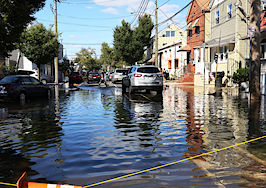Property data provider ATTOM says it’s now providing risk assessments for every U.S. property measuring their current and future exposure to climate-change-related hazards including wildfires, floods, and drought.
ATTOM’s climate change risk data, sourced from the startup ClimateCheck, provides projections going as far out as 2050, when a borrower who takes out a 30-year mortgage today may still be making payments.
The company expects the data will be used to evaluate properties for investment decisions, assess risk for new product development, and to inform consumers visiting real estate portals.

Todd Teta
“With the addition of this new data product clients will be able to better mitigate risk, streamline decision making and gain deeper intelligence on the housing market,” Todd Teta, chief product and technology officer at ATTOM, said in a statement.
ClimateCheck has assessed all U.S. properties with a 0-100 rating for five climate change hazards: wildfire, flood, heat, storm and drought. The risk data, which will be updated quarterly, is currently available through ATTOM for delivery via bulk files. The company says integration to ATTOM Cloud and API is “coming soon.”
A recent report by the Mortgage Bankers Association’s Research Institute for Housing America (RIHA) warned that “Climate change will impact all governments, industries and individuals. Housing and housing finance will not be spared.”
The report warned that climate change is likely to stretch the National Flood Insurance Program to the breaking point, undermine home prices in vulnerable communities, and drive more homeowners to default on their mortgages.
“Increasingly devastating storms, excessive heat and wildfires, drought, and more all have the capacity to damage and destroy property,” the report said.
An analysis by the First Street Foundation projects that average annual dollar losses due to flooding will increase 61 percent by 2051, to nearly $32.2 billion, and that rates on NFIP policies would have to be increased by 4.5 times if all properties at risk were insured.
Consumers and other real estate stakeholders have a growing number of tools to help them assess risk. The First Street Foundation provides dollar estimates of flood damage for individual residential homes through a flood risk assessment tool, Flood Factor, that’s integrated into real estate listing websites like realtor.com and Redfin.
ClimateCheck’s data has been added to a number of search portals, including Movoto by OJO Labs, RealScout and Redfin. CEO Cal Inman, who has said the company’s goal is to make its data available with every online real estate listing, said in an email that ATTOM users can use ClimateCheck’s risk ratings for analytics purposes, or display them on their websites. (Cal Inman is the son of Brad Inman, founder of Inman Group. Inman Group is not affiliated with ClimateCheck.)
The Department of Housing and Urban Development isn’t required to disclose flood risk to would-be homebuyers, and homes that it repossessed and sold between 2017 and 202 were almost 75 times more likely to be in federally designated floodplains than other homes sold during that timeframe, according to an analysis of nearly 100,000 homes sales by NPR.
Most HUD buyers who bought in a flood zone didn’t find out about the issue until they were told by their lender that they needed to buy flood insurance, NPR found.
HUD recently published a climate adaptation and resilience plan which outlines objectives that include reducing climate-related financial risks to HUD mortgage programs.
Editor’s note: This story has been updated to note that ATTOM is sourcing climate change risk data from ClimateCheck.
Get Inman’s Extra Credit Newsletter delivered right to your inbox. A weekly roundup of all the biggest news in the world of mortgages and closings delivered every Wednesday. Click here to subscribe.





